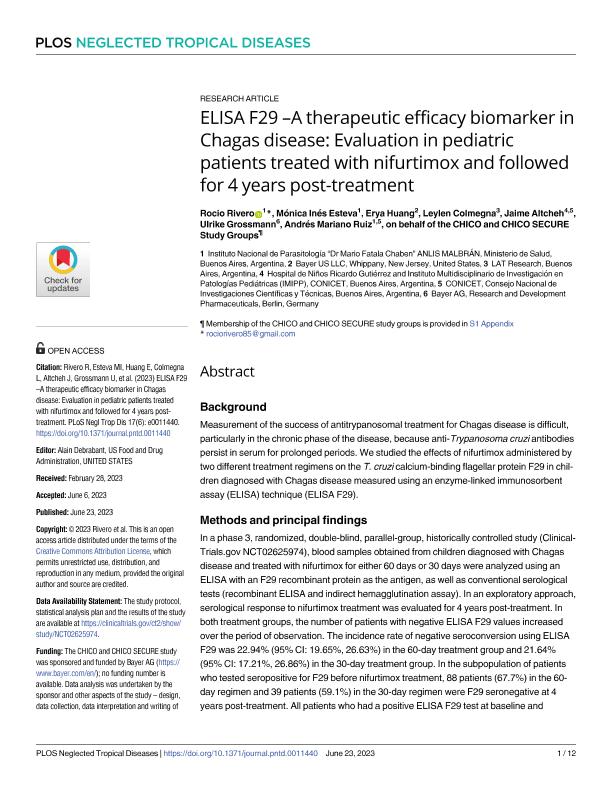Mostrar el registro sencillo del ítem
dc.contributor.author
Rivero, Rocío

dc.contributor.author
Esteva, Mónica Inés

dc.contributor.author
Huang, Erya
dc.contributor.author
Colmegna, Leylen
dc.contributor.author
Altcheh, Jaime Marcelo

dc.contributor.author
Grossmann, Ulrike
dc.contributor.author
Ruiz, Andrés Mariano

dc.date.available
2024-02-21T15:45:57Z
dc.date.issued
2023-06
dc.identifier.citation
Rivero, Rocío; Esteva, Mónica Inés; Huang, Erya; Colmegna, Leylen; Altcheh, Jaime Marcelo; et al.; ELISA F29 –A therapeutic efficacy biomarker in Chagas disease: Evaluation in pediatric patients treated with nifurtimox and followed for 4 years post-treatment; Public Library of Science; PLoS Neglected Tropical Diseases; 17; 6; 6-2023; 1-12
dc.identifier.issn
1935-2735
dc.identifier.uri
http://hdl.handle.net/11336/227889
dc.description.abstract
Background Measurement of the success of antitrypanosomal treatment for Chagas disease is difficult, particularly in the chronic phase of the disease, because anti-Trypanosoma cruzi antibodies persist in serum for prolonged periods. We studied the effects of nifurtimox administered by two different treatment regimens on the T. cruzi calcium-binding flagellar protein F29 in children diagnosed with Chagas disease measured using an enzyme-linked immunosorbent assay (ELISA) technique (ELISA F29). Methods and principal findings In a phase 3, randomized, double-blind, parallel-group, historically controlled study (Clinical-Trials.gov NCT02625974), blood samples obtained from children diagnosed with Chagas disease and treated with nifurtimox for either 60 days or 30 days were analyzed using an ELISA with an F29 recombinant protein as the antigen, as well as conventional serological tests (recombinant ELISA and indirect hemagglutination assay). In an exploratory approach, serological response to nifurtimox treatment was evaluated for 4 years post-treatment. In both treatment groups, the number of patients with negative ELISA F29 values increased over the period of observation. The incidence rate of negative seroconversion using ELISA F29 was 22.94% (95% CI: 19.65%, 26.63%) in the 60-day treatment group and 21.64% (95% CI: 17.21%, 26.86%) in the 30-day treatment group. In the subpopulation of patients who tested seropositive for F29 before nifurtimox treatment, 88 patients (67.7%) in the 60-day regimen and 39 patients (59.1%) in the 30-day regimen were F29 seronegative at 4 years post-treatment. All patients who had a positive ELISA F29 test at baseline and seroconverted to negative measured by conventional serology reached seronegativity in ELISA F29 earlier than in conventional serology. Conclusions The results demonstrate a serological response to treatment with nifurtimox measured by the ELISA F29 test in children diagnosed with Chagas disease. The F29-based ELISA can be considered a potential early marker of response to antitrypanosomal therapy for Chagas disease.
dc.format
application/pdf
dc.language.iso
eng
dc.publisher
Public Library of Science

dc.rights
info:eu-repo/semantics/openAccess
dc.rights.uri
https://creativecommons.org/licenses/by/2.5/ar/
dc.subject
CHAGAS
dc.subject
CHILDREN
dc.subject
F29
dc.subject
TREATMENT
dc.subject.classification
Pediatría

dc.subject.classification
Medicina Clínica

dc.subject.classification
CIENCIAS MÉDICAS Y DE LA SALUD

dc.title
ELISA F29 –A therapeutic efficacy biomarker in Chagas disease: Evaluation in pediatric patients treated with nifurtimox and followed for 4 years post-treatment
dc.type
info:eu-repo/semantics/article
dc.type
info:ar-repo/semantics/artículo
dc.type
info:eu-repo/semantics/publishedVersion
dc.date.updated
2024-02-20T12:21:45Z
dc.journal.volume
17
dc.journal.number
6
dc.journal.pagination
1-12
dc.journal.pais
Estados Unidos

dc.journal.ciudad
San Francisco
dc.description.fil
Fil: Rivero, Rocío. Dirección Nacional de Instituto de Investigación. Administración Nacional de Laboratorio e Instituto de Salud "Dr. C. G. Malbrán". Instituto Nacional de Parasitología "Dr. Mario Fatala Chaben"; Argentina
dc.description.fil
Fil: Esteva, Mónica Inés. Dirección Nacional de Instituto de Investigación. Administración Nacional de Laboratorio e Instituto de Salud "Dr. C. G. Malbrán". Instituto Nacional de Parasitología "Dr. Mario Fatala Chaben"; Argentina
dc.description.fil
Fil: Huang, Erya. Bayer US LLC; Estados Unidos
dc.description.fil
Fil: Colmegna, Leylen. LAT Research; Argentina
dc.description.fil
Fil: Altcheh, Jaime Marcelo. Gobierno de la Ciudad de Buenos Aires. Instituto Multidisciplinario de Investigaciones en Patologías Pediátricas. Consejo Nacional de Investigaciones Científicas y Técnicas. Oficina de Coordinación Administrativa Houssay. Instituto Multidisciplinario de Investigaciones en Patologías Pediátricas; Argentina
dc.description.fil
Fil: Grossmann, Ulrike. Bayer AG; Alemania
dc.description.fil
Fil: Ruiz, Andrés Mariano. Dirección Nacional de Instituto de Investigación.Administración Nacional de Laboratorios e Institutos de Salud "Dr. Carlos G. Malbrán"; Argentina
dc.journal.title
PLoS Neglected Tropical Diseases

dc.relation.alternativeid
info:eu-repo/semantics/altIdentifier/url/https://journals.plos.org/plosntds/article?id=10.1371/journal.pntd.0011440
dc.relation.alternativeid
info:eu-repo/semantics/altIdentifier/doi/http://dx.doi.org/10.1371/journal.pntd.0011440
Archivos asociados
